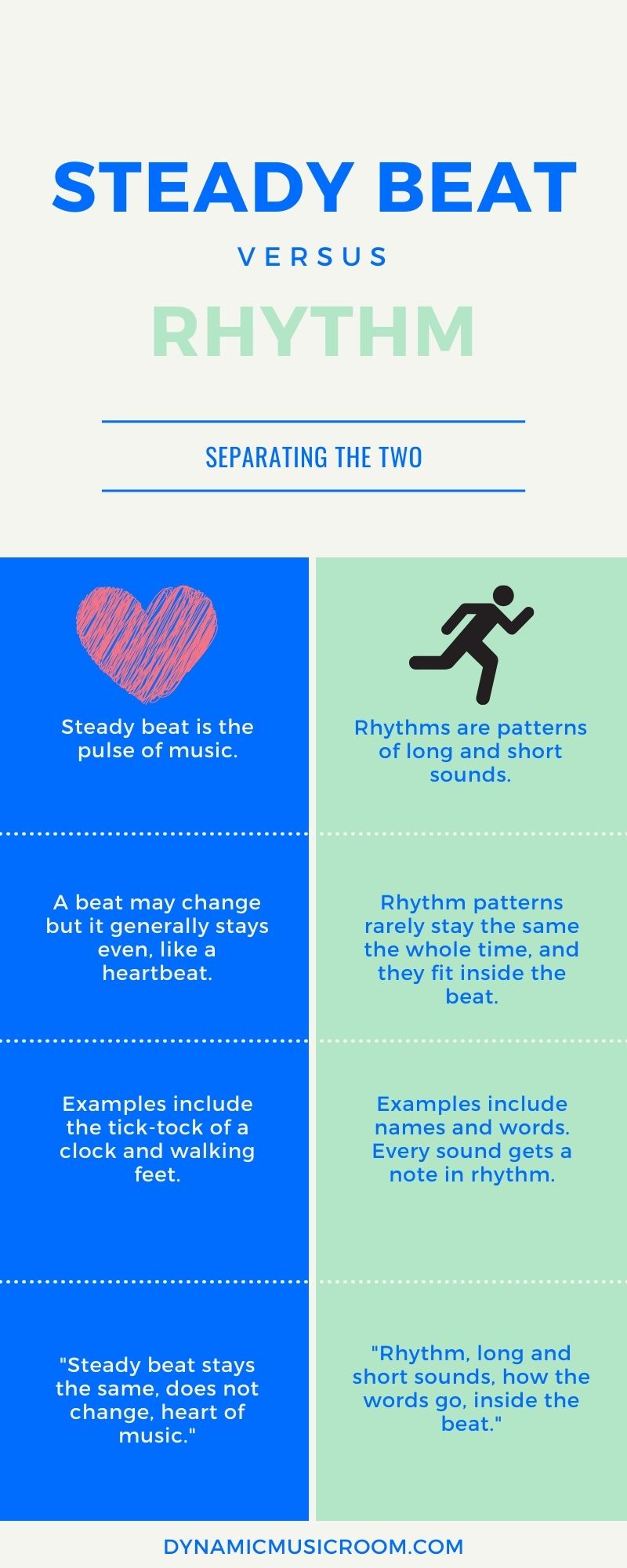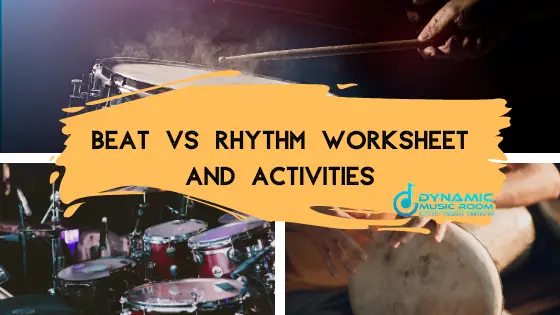Are your kids like mine, and they struggle to tell the difference between beat and rhythm?
Don’t worry! You are most definitely not alone.
Telling the difference between beat and rhythm is a problem I’ve seen even with adults.
This is why I have come up with a beat vs rhythm worksheet.
The beat vs rhythm worksheet helps students tell the difference between steady beat (which is the pulse of music) and rhythm (which are the long and short sounds that occur over the beat).
Check out the rest of the article for how to use the worksheet and other strategies you may want to help your students tell the difference between beat and rhythm.

Save time with these 60 FREE Music Resources to use in your room right away!
Stop searching the whole internet to find good activities. I’ll help you cut to the chase with my favorite 60 FREE resources.
Table of Contents
What Is A Steady Beat?
Before we begin to have students differentiate between beat and rhythm, they need to have a solid understanding of steady beat.
With my younger elementary students, I use the following language:
- Steady beat is nice and even.
- It doesn’t change.
- It stays the same.
- Steady beat is the heart of music.
We all know the beat is more than this, and the beat can change.
But for kids, this explanation, though simple, is a good place to start.
Some activities to help reinforce the beads include the following:
- Patting the beat in different places on their bodies while recorded music plays
- Using pictures of same size shapes to represent the steady beat (such as hearts)
- Drawing their own steady beat shapes
- Finding sounds that make steady beat around the room and in their lives
- Telling the difference between steady and unsteady beat in their own words.
Read more: Steady beat songs with popular music
What Is Rhythm?
In essence, rhythm is the pattern of long and short sound over the steady beat.
The steady beat is unaffected by rhythm, but the rhythm can only exist within the beat.
Rhythm involves a lot more than just this, but if your kids understand this part of it, then they’ll have a good grasp of what rhythm is.
For more information on rhythm, check out our detailed guide on what are the parts of rhythm.
Some sample activities for understanding rhythm include the following:
- Clapping the words of a son
- Reading rhythm using words or rhythm syllables from pictures that are in groups of ones and twos to represent different types of rhythm
- Moving to the words of a song and not the beat
- Arranging manipulative shapes to create their own rhythms
- Drawing their own shapes to represent rhythm
What Is The Difference Between Rhythm And Beat?

The beat is the unheard, but felt, pulse that holds the music together. Rhythm is the long and short sounds as they exist in relation to the beat. Another way to think of rhythm is that rhythm is how to the words go.
Beats Vs Rhythm Worksheet And Strategies
The best way to tell the difference between two things is to compare them side by side.
We need to show this difference using multiple intelligences in order to reach all students and develop that understanding in the brain as best we can.
In this section, I’ll offer an example activity for a few of the different learning styles to better help students tell the difference between beat and rhythm.
At the end, you’ll also find a link to download my beat vs rhythm worksheet.
Kinesthetic
Kinesthetic, or movement, is probably the easiest way to tell the difference between the two concepts. Here is one such strategy:
- Start with a well-known song such as Rain Rain Go Away.
- Have the students pat the steady beat on their laps while they sing the song.
- Have the students clap the words or rhythm of the song while they sing.
- Now I have the students pat the beat again, but this time I clap the words while they sing.
- Then we switch jobs.
- I’ll also, if they’re handling it well, split the class into groups and have them handle the beat and the rhythm.
- After we’ve done this a few times, we’ll have a discussion on what it felt like and how the two groups lined up or didn’t line up with each other.
Visual
The visual of rhythm and beat make the most sense to me, but that’s probably just my learning style. Many students get a lot from the iconic representation of beat and rhythm.
Here’s how I handle it:
- For this, I have hearts representing the beats and stars in groups of one and two representing the rhythms. The hearts are the same size and spread throughout the visual, and the stars are placed inside the hearts.
- I’ll ask the students which image is representing the beat and which image is representing the rhythm.
- They also are expected to explain their reasoning. (Even if they have a hard time getting that into words, the process of trying to reason out your right or wrong answer will help them develop their knowledge.)
- I’ll then show the same ideas with different visuals such as a circle for beats and squares for rhythms.
The beat versus rhythm worksheet downloadable at the button at the end of this section does a great job of showing this part of teaching beat and rhythm.
Creative
During the creative portion of learning the difference between beat and rhythm, students are given manipulatives such as cut out hearts and cut out stars which they have to use to arrange and create their own rhythms.
This act of creation will help them better understand how the rhythms fit on top of the beat and how the beats are interchangeable because they are even.
This can be done in the whole group, small group, or independently depending on your time, space, and resources available.
Socially
Social learning is a type of learning style, and one that should not be ignored.
The act of working together or re-explaining your thoughts is a huge help in developing knowledge, especially with older students.
One social learning activity I’ll do is called mixed-pair-share.
- Have the students mix around the room while music is playing.
- When the music stops, the students must pair up with the nearest person, and they begin this activity.
- Each student takes turns either patting the beat or clapping the rhythm. The other student has to tell whether they heard a steady beat or rhythm.
- Repeat several times with other student partners.
- For an even greater challenge, students have put the beat and the rhythm in the clap. This way it’s harder to tell the difference.
This may seem simple, but the difference is actually really simple between the two, it just takes some reinforcement.
The worksheet, downloadable at the button below, was designed with younger grades in mind, but the worksheet will work well with older kids.
How Does Beat And Rhythm Compare To Melody?
The beat is the heart of music, and rhythm is the long and short sounds that fit into the heartbeat.
Melody is what happens when you add pitch (high and low) to the rhythm.
I like to describe it to my students as a math problem:
Rhythm + Pitch = Melody.
The beat comes in as the glue that holds the rhythm together and gives it some context.
The melody contains rhythm, but the rhythm doesn’t always have the melody (such as in spoken chants or raps).
A lot of music teachers jump right to teaching melody as soon as they add pitch, but it’s important to give them some practice with pitch separate from the rhythm elements.
How Does Tempo Apply To Beat Vs. Rhythm?
Tempo is essentially the speed of the beat.
Mathematically, it’s measured in beats per minute (BPM).
Rhythm isn’t directly impacted by tempo, but since the tempo dictates the speed of the beat, the rhythm is also impacted as a secondary result.
Faster tempi (plural of tempo) result in faster rhythmic values.
But there can be a slow tempo with fast rhythms.
If the tempo is slow and you play a bunch of sixteenth notes, it’ll feel faster than a fast tempo made of all whole note and half note rhythms.
For this reason, music teachers need to be intentional when they talk about tempo and ask questions.
Make sure you ask something like:
What is the tempo or speed of the beat of this song?
Rather than a simpler but more confusing:
How fast is this song?
When Should I Teach Beat and Rhythm?
Teaching steady beat is something we work on right from preschool onward.
You’re never really done teaching it as your kids will need the work for their whole lives.
How many times have we gone to sporting events only to cringe when the crowd can’t follow the band after all?
I hold off on pointing out the main difference between beat and rhythm until first grade myself, though it’s OK to allude to it in later Kindergarten as well.
In general, your students need to have a firm grasp on a steady beat before you start challenging them with rhythm elements.
Conclusion
I hope you find this beat vs rhythm worksheet helpful.
The difference between these two concepts is key for developing further knowledge in music.
Did any of these strategies surprise you?
Do you have your own tracks for beat versus rhythm?


